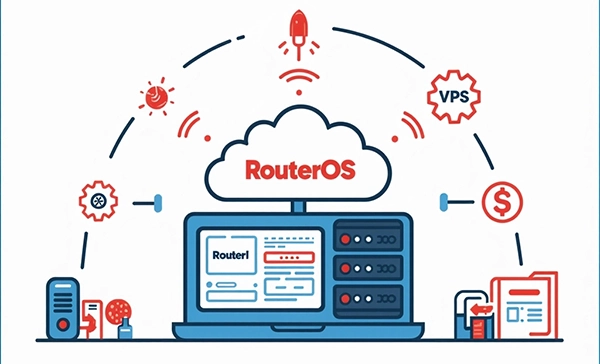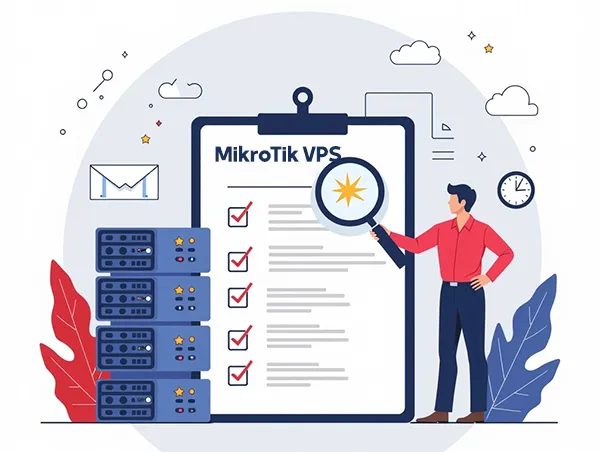MikroTik VPS is a Virtual Private Server that runs on MikroTik RouterOS, a specialized operating system designed for advanced network management. Instead of using physical MikroTik routers, you can deploy RouterOS in a cloud-based VPS environment, giving you all the features of enterprise-grade hardware without the cost of purchasing and maintaining physical equipment. This setup provides complete control over routing, firewalls, bandwidth management, VPN connections, and load balancing, all from a virtual platform accessible anywhere.

The main purpose of a MikroTik VPS is to deliver powerful networking capabilities to businesses, hosting providers, and internet service providers (ISPs). With this virtual solution, you can create secure VPN tunnels, manage large-scale bandwidth allocation, configure complex routing rules, and protect data traffic with advanced firewall settings. It is particularly valuable for companies that require high reliability and scalability but want to avoid the expense of traditional hardware-based solutions.
Because the VPS is hosted in the cloud, you can easily scale resources on demand, apply updates remotely, and maintain high levels of uptime. Whether you’re setting up a private network for a business, optimizing traffic for a hosting company, or delivering internet services as an ISP, a MikroTik VPS offers the flexibility and control needed to build a powerful, secure, and future-ready network.
MikroTik VPS vs. Traditional VPS Hosting
When comparing a MikroTik VPS to a traditional VPS hosting service, the key difference lies in the operating system and the server’s primary purpose. A standard VPS typically runs on common operating systems such as Linux or Windows and is used to host websites, applications, or databases. In contrast, a MikroTik VPS is specifically designed to run RouterOS, a network-focused platform that turns the virtual server into a powerful router, firewall, and traffic management system. This specialized environment gives network administrators far more control over routing, bandwidth shaping, VPN connections, and overall network security than a general-purpose VPS.
Another major distinction is the feature set and flexibility. Traditional VPS hosting is optimized for tasks like web hosting, email management, or running cloud applications, but it usually requires third-party tools to handle complex networking tasks. A MikroTik VPS, on the other hand, includes built-in tools such as advanced firewalls, dynamic routing protocols, traffic queues, and VPN servers. These features are ready to use immediately after deployment, allowing businesses and ISPs to create custom network solutions without relying on additional software or hardware.
Finally, there are important differences in management and scalability. With a traditional VPS, administrators often need to configure multiple services and security layers to achieve the same level of network control that MikroTik offers natively. MikroTik VPS hosting provides a more streamlined experience by focusing on networking performance and scalability from the start. Because it is cloud-based, users can upgrade resources, apply updates, and implement new routing rules quickly and remotely. For organizations that prioritize networking efficiency, security, and cost savings, a MikroTik VPS delivers a level of functionality that traditional VPS hosting simply cannot match.
Key Benefits of Using a MikroTik VPS for Businesses

A MikroTik VPS provides businesses with enterprise-level networking capabilities without the need to purchase expensive hardware routers. By deploying MikroTik’s RouterOS on a virtual private server, organizations gain access to advanced features such as dynamic routing, bandwidth management, firewall protection, and VPN configuration all within a scalable cloud environment. This means companies can expand or reduce resources based on demand, ensuring they only pay for what they need while maintaining peak performance.
Another significant benefit is cost efficiency. Traditional networking hardware often requires large upfront investments and ongoing maintenance costs. With a MikroTik VPS, businesses avoid these expenses and instead operate on a pay-as-you-go model, making it ideal for startups, SMEs, and even large enterprises looking to optimize their IT budgets. The virtual setup also eliminates physical space requirements and allows for instant upgrades, saving both time and money compared to traditional hardware solutions.
Additionally, a MikroTik VPS enhances security and flexibility. RouterOS includes robust security tools such as configurable firewalls, encrypted VPNs, and access control lists that protect sensitive data and prevent unauthorized access. Businesses can customize their network to meet specific requirements, whether they need to support remote teams, manage multiple branch connections, or implement strict quality-of-service (QoS) rules to prioritize critical traffic.
Main Use Cases of MikroTik VPS in Networking and the Internet
The versatility of a MikroTik VPS makes it suitable for a wide range of networking scenarios. One of the most common applications is for internet service providers (ISPs) who need to manage traffic for large numbers of users while maintaining high performance and security. ISPs can use a MikroTik VPS to handle tasks like traffic shaping, bandwidth allocation, and advanced routing without the need for costly on-premise hardware.
Businesses also deploy MikroTik VPS servers to create secure VPN connections between remote offices, data centers, or mobile teams. With RouterOS’s built-in VPN capabilities, organizations can easily set up encrypted tunnels for safe data transmission across multiple locations. This is especially valuable for companies with distributed workforces or those requiring secure access to internal systems from outside networks.
Another popular use case is network optimization and monitoring. Companies can leverage the MikroTik VPS to balance network loads, enforce traffic prioritization, and analyze real-time network statistics. This ensures stable connectivity for critical services like VoIP, video conferencing, and cloud applications while reducing latency and preventing congestion.
For more ideas on practical implementations, check out Best Use Cases of VPS Server to explore scenarios where VPS hosting delivers maximum value.
Why Network Administrators Prefer MikroTik VPS

Network administrators often choose a MikroTik VPS because it provides powerful tools and an intuitive interface that simplify complex networking tasks. RouterOS supports a wide range of protocols and configurations, giving admins granular control over routing, firewall settings, and bandwidth management. This level of flexibility allows them to build custom network solutions tailored to specific business needs without relying on additional hardware or third-party services.
The cloud-based nature of a MikroTik VPS also means that administrators can manage the network remotely, apply updates, and monitor performance in real time. This reduces downtime and enables quick responses to any potential issues, ensuring that network operations remain smooth and secure. Features like automatic backups, detailed logging, and advanced diagnostics make troubleshooting and maintenance easier than with traditional hardware routers.
Moreover, MikroTik VPS hosting is renowned for its scalability and cost-effectiveness. Administrators can upgrade CPU, RAM, or storage resources instantly as the network grows, avoiding the delays and expenses associated with physical equipment upgrades. For professionals seeking a reliable, high-performance, and flexible networking solution, a MikroTik VPS provides an unmatched combination of control, security, and efficiency.
Important Factors to Check Before Purchasing a MikroTik VPS

Before investing in a MikroTik VPS, it’s essential to evaluate a few key factors to ensure the service matches your network needs. First, consider the server specifications such as CPU performance, RAM, storage type (SSD vs. HDD), and bandwidth limits. These resources directly affect the performance of RouterOS features like routing, VPN encryption, and firewall rules. Choosing a plan with enough processing power and memory will help maintain stable network operations, especially if you plan to handle heavy traffic or complex configurations.
Second, check the hosting provider’s data center location and network quality. Selecting a VPS geographically closer to your target users or branch offices will reduce latency and improve overall connection speeds. Reliable network uptime and redundant infrastructure are also critical to maintaining consistent service availability. Look for providers that guarantee at least 99.9% uptime and offer fast, low-latency connections for optimal performance.
Finally, evaluate the security and support options offered by the provider. A trustworthy host should provide features like DDoS protection, regular backups, and strong physical data center security. In addition, responsive 24/7 technical support can make a huge difference when troubleshooting issues or performing urgent updates. Choosing a provider with proven reliability and excellent customer service ensures that your MikroTik VPS remains stable and secure at all times.
How to Choose the Best MikroTik VPS Plan for Your Needs
Selecting the right MikroTik VPS plan starts with understanding your current and future network requirements. Begin by assessing the size of your user base, the expected amount of traffic, and the types of services you plan to run, such as VPNs, firewalls, or bandwidth management tools. This information will help you determine the appropriate amount of CPU power, memory, and disk space required to maintain smooth performance.
Price is an important consideration, but it should not be the only factor. A cheaper plan may seem attractive, but if it lacks the resources or scalability you need, it could lead to performance issues or costly upgrades later. Look for hosting providers that offer flexible plans with easy scaling options, allowing you to adjust resources as your business grows. Transparent pricing with no hidden fees is also essential for effective budget planning.
Additionally, consider the management level and extra features included in the plan. Some MikroTik VPS providers offer managed services, which include regular updates, security monitoring, and technical assistance. Others provide self-managed plans for experienced administrators who prefer full control over configurations. Choosing between managed or unmanaged hosting depends on your technical expertise and how much time you want to dedicate to server maintenance.
Step-by-Step Guide to Buying a MikroTik VPS from Reliable Providers
Purchasing a MikroTik VPS is a straightforward process, but following a clear step-by-step approach will help you avoid common mistakes. Start by researching and comparing reputable hosting providers that specialize in MikroTik VPS hosting. Read customer reviews, check performance benchmarks, and verify that the provider offers RouterOS compatibility and the necessary resources for your network requirements.
Once you have selected a provider, the next step is to choose the appropriate plan. Carefully evaluate CPU, RAM, storage, and bandwidth options to ensure the package meets your current needs and allows for future scaling. Some providers may also offer trial periods or money-back guarantees, which can be useful if you want to test performance before committing long-term.
Finally, proceed with the sign-up and setup process. After registering, you will typically receive login credentials and access to a control panel where you can install and configure RouterOS. At this stage, it’s important to set strong passwords, enable available security features, and schedule regular backups to safeguard your new server. Completing these steps ensures that your MikroTik VPS is ready for deployment with maximum performance and protection.
Initial Installation and Setup of a MikroTik VPS

Setting up a MikroTik VPS begins as soon as you receive your server credentials from the hosting provider. After logging into the control panel, you’ll typically find RouterOS pre-installed or available as a one-click installation option. Start by confirming that the RouterOS version is up to date, since using the latest release ensures access to new features and important security patches. Once verified, create a secure administrator password and configure remote access methods, such as SSH or Winbox, to manage the server safely.
Next, configure the basic network settings. Assign IP addresses, gateways, and DNS servers based on your network plan. For administrators running multiple services, it’s recommended to set up VLANs or routing tables early in the process to simplify traffic management later. At this stage, you can also enable logging to track network activity and monitor system performance in real time. Proper initial setup ensures that your MikroTik VPS operates efficiently from the start and minimizes the risk of future configuration errors.
Finally, consider creating a backup of the initial configuration before making complex changes. This allows you to restore a clean setup if anything goes wrong during advanced customization. Taking a cautious, step-by-step approach during installation ensures a stable foundation for building a secure and high-performance network.
Essential Security Configurations to Protect Your MikroTik Server

Security is one of the most critical aspects of running a MikroTik VPS, and configuring it correctly from the beginning can prevent costly breaches. Start by disabling unused services such as Telnet or FTP to reduce potential attack surfaces. Use strong, unique passwords and enable two-factor authentication if supported by your hosting provider. Restrict access to the management interface by creating firewall rules that allow connections only from trusted IP addresses.
Another important measure is to configure encrypted VPN access for administrative tasks. Using VPN tunnels such as IPsec or OpenVPN ensures that all traffic between your devices and the MikroTik VPS remains private and protected from eavesdropping. You should also enable logging and intrusion detection features to identify suspicious activity in real time. These tools provide valuable data for analyzing potential threats and taking proactive action.
Finally, keep RouterOS and all packages regularly updated. MikroTik frequently releases patches to fix vulnerabilities and enhance security. Setting up automatic updates or scheduling routine checks helps maintain the highest level of protection. By implementing these essential security practices, you can safeguard your network and maintain user trust while enjoying the advanced capabilities of a MikroTik VPS.
Firewall Configuration and Traffic Control on MikroTik VPS
A properly configured firewall is the backbone of any secure and efficient network, and MikroTik’s RouterOS offers powerful tools to create detailed firewall rules. Begin by setting up basic filtering rules that block unauthorized traffic while allowing essential services. For example, restrict management ports to specific IP ranges and drop all unexpected inbound connections. These foundational rules help protect your MikroTik VPS from common threats like DDoS attacks and port scanning attempts.
Next, take advantage of RouterOS’s advanced features for traffic control and bandwidth management. Queue trees, simple queues, and mangle rules allow administrators to prioritize critical traffic, such as VoIP or video conferencing, while limiting less important services during peak hours. This ensures that essential applications remain stable even when network usage is high.
For large or complex networks, implement dynamic firewall rules and address lists. These tools automate security responses by blocking suspicious IPs, redirecting malicious traffic, or adjusting bandwidth allocations based on real-time conditions. By combining strong security policies with intelligent traffic control, a MikroTik VPS can deliver both robust protection and optimized performance for any business environment.
Managing Users and Access Permissions in MikroTik VPS

Effective user management is essential for keeping your MikroTik VPS secure and organized. Begin by creating individual accounts for each administrator or team member who needs access, rather than sharing a single login. This approach provides accountability and allows you to track changes made by specific users. Assign each account a unique, strong password and restrict access to only the services that person requires. For example, a technician responsible for monitoring traffic should not have the same privileges as someone configuring firewall rules.
RouterOS offers flexible group and permission settings that let you define custom access levels. You can create user groups for different roles, such as network admins, support staff, or monitoring teams, and assign granular permissions to each group. By doing so, you maintain tight control over critical system functions and reduce the risk of accidental misconfigurations or unauthorized changes.
It is also important to implement regular user audits. Review user accounts periodically to disable inactive profiles and update permissions when team responsibilities change. Enforcing these best practices helps ensure that only authorized personnel can access sensitive configurations, maintaining the security and stability of your MikroTik VPS.
Backup and Restore Procedures for MikroTik VPS
Regular backups are crucial to protecting your MikroTik VPS against data loss, configuration errors, or unexpected system failures. MikroTik RouterOS provides built-in tools to create full configuration backups or export specific settings for easy restoration. It’s a good practice to schedule automated backups at regular intervals, such as daily or weekly, and store them in secure off-site locations or encrypted cloud storage.
When creating a backup, ensure that critical elements like firewall rules, routing tables, and VPN configurations are included. RouterOS allows you to generate a binary backup for quick, complete recovery, as well as an export file for detailed review and manual restoration. Keeping multiple backup versions can also help you roll back to a stable configuration if a recent change causes problems.
Restoring a MikroTik VPS from a backup is straightforward. Using the Winbox interface or command line, you can import the saved configuration and apply it immediately. Regular testing of your restore process ensures that backups are functional and reliable, giving you peace of mind in case of hardware failure, cyberattacks, or accidental misconfigurations.
Optimizing the Speed and Performance of Your MikroTik VPS

To get the most out of your MikroTik VPS, it’s important to fine-tune performance settings for maximum speed and efficiency. Start by monitoring system resources such as CPU load, memory usage, and network throughput using RouterOS’s built-in tools. Identifying bottlenecks early allows you to upgrade resources or adjust configurations before performance issues affect end users. For additional techniques, see How To Optimize Your VPS Hosting Server for a complete VPS optimization checklist.
Traffic management plays a key role in optimization. Use RouterOS features like Queue Trees and Simple Queues to prioritize critical services, ensuring that essential applications such as VoIP, video conferencing, and database connections remain stable even during peak traffic hours. Properly designed Quality of Service (QoS) policies can dramatically improve user experience by minimizing latency and packet loss.
Regular maintenance is also critical for sustained performance. Keep RouterOS updated, clean up unused firewall rules, and periodically review routing tables to remove outdated entries. If your network demands increase over time, consider scaling your VPS plan to add CPU, RAM, or bandwidth. With careful monitoring and proactive adjustments, your MikroTik VPS can deliver fast, reliable service that meets the needs of even the most demanding networks.
Troubleshooting and Fixing Common Issues on MikroTik VPS

Even with a well-configured MikroTik VPS, occasional issues such as connectivity drops, high CPU usage, or routing conflicts can occur. The first step in troubleshooting is to use RouterOS’s built-in diagnostic tools like Ping, Traceroute, and Torch to identify where the problem originates. Checking the system logs is equally important, as detailed logs often reveal misconfigurations, failed authentication attempts, or hardware resource limits.
Another common challenge is firewall misconfiguration, which can unintentionally block legitimate traffic. Carefully reviewing firewall rules and using a step-by-step testing method helps pinpoint errors without disrupting critical services. If performance issues persist, examine bandwidth usage with tools like Queue Trees and traffic flow monitoring to detect network congestion or malicious activity such as DDoS attacks.
When all else fails, restoring from a recent backup can quickly resolve persistent issues. Keeping multiple backup versions ensures you can roll back to a stable configuration without losing important data. Combined with proactive monitoring, regular updates, and documented change logs, these troubleshooting practices keep your MikroTik VPS running smoothly and securely.
Conclusion
A MikroTik VPS delivers enterprise-grade networking power in a cost-effective, cloud-based environment. By running RouterOS on a virtual server, businesses, ISPs, and network administrators gain advanced features such as dynamic routing, bandwidth management, and powerful firewalls, all without the expense of physical hardware. This flexibility makes MikroTik VPS hosting an ideal choice for organizations seeking scalability, reliability, and strong security.
Before purchasing, carefully evaluate your provider’s reputation, server specifications, and support quality. Selecting a plan with sufficient CPU, memory, and bandwidth will ensure that your network performs reliably even as traffic grows. Implementing strong security measures and regular backups from the start will protect your infrastructure and simplify future upgrades.
Whether you’re building a secure corporate network, optimizing bandwidth for a hosting service, or offering internet connectivity as an ISP, a MikroTik VPS provides the tools and flexibility to meet your needs today while preparing for tomorrow’s demands. With careful planning and ongoing maintenance, it can serve as the backbone of a powerful, future-ready network.










Leave a Reply